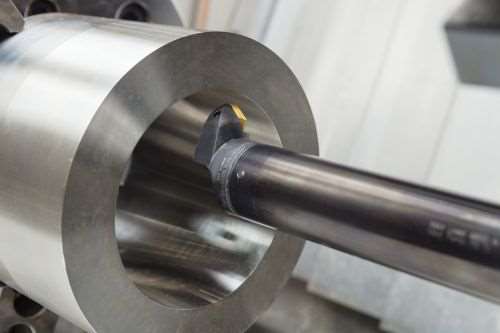Enjoy the Silence with Vibration Damping Tools
Tech Brief: One method to counteract vibration is to use light cutting and a modified tool approach.
When it comes to internal turning with long overhangs, vibration can be your toughest enemy. One method to counteract vibration is to use light cutting and a modified tool approach. But that approach may sacrifice production time. A better option is to tackle those deflection forces with tools engineered for exactly this task.
Two types of vibrations occur in machining: force vibration and natural-occurring frequency. Force vibration is a result of the variation in the cutting forces. Chip segmenting processes, inclusions in the material, oval workpieces, interrupted cuts, or formation of built-up edge can all cause the cutting forces to vary and contribute to force vibration. The force vibration triggers the tool’s self-induced vibration, oscillating at a specific frequency called the “natural frequency” where the tool continues to vibrate.
Featured Content
Traditionally, minimizing vibration would be done by reducing cutting forces by a trial and error process of changing the tooling concept, inserts and type of clamping. Another approach would be to minimize deflection by increasing the diameter of the tool, or shortening the length, to increase static stiffness. Alternatively, the dynamic stiffness can be raised by reducing weight in front of the tool and/or adding a dampening mechanism.
Advanced Damping Technology
Silent Tools fight vibration with a damping unit inside the bar. When cutting forces cause the bar to vibrate, the damping mechanism, which consists of a heavy mass supported on rubber spring elements, starts to vibrate. Oil inside the unit increases the damping effect. The vibration energy is dissipated in the form of heat, and as a result, the vibrations die out quickly.
Usage for Internal Turning
Internal turning applications usually involve a range of tool overhangs. The length of bores are deep in many of the components involved, demanding boring bar overhangs from 4× to 14× the diameter. Therefore, tool selection and its correct application are crucial to the result, as internal turning tends to be especially sensitive to vibration tendencies. Building the damping mechanism as close to the cutting edge as possible is beneficial, as it provides the quickest response to any vibration tendencies.
Ordinary steel boring bars are sufficient for overhangs of as much as 4× the diameter. For overhangs of 6× the diameter, solid carbide bars can be used. In areas with long overhangs, damped boring bars are necessary. Steel damped bars for overhangs of 10× the diameter and carbide reinforced damped bars for 14× the diameter. Grooving and threading, however, generally have lower overhang possibilities. Furthermore, all machine tools have their individual specifications and stability lobes—frequency areas where machines react during machining. It is therefore important that standard vibration damping tools are developed to work in as large of a frequency area as possible.
Diameters are Crucial
Standard damped boring bars for turning are available. Bar diameters range from 0.375 inch to 10 inches (10 mm to 250 mm). Larger diameters require an engineered tooling solution.
The three reasons to apply a damped boring bar in internal turning are to maintain tolerance and surface finish levels, to minimize machining time through the smallest number of passes and to achieve competitive, economical machining rates. Productivity and security are the key words here as many components are subjected to competitive pressures in manufacturing.
The availability of boring bar and cutting head combinations for internal turning is advantageous. For holes smaller than 0.787 inch (20 mm), there is a range of different T- and D-shaped insert types, providing optimization opportunities for operations at hand. This might be the case with tight tolerance limits, as well as for hard part turning.
For holes with diameters of 0.787 inch (20 mm) or more, exchangeable cutting heads play a vital role for flexibility, security and efficient tool handling. ISO-standard Coromant Capto modular tooling couplings and serration locking (SL) interfaces play an important role in providing the most suitable solutions. The SL quick-change and setting functions have been developed to improve setting and performance and to enable the availability of a large assortment of indexable inserts.
The right internal turning methods can make a substantial difference in performance, security and results. One example is Sandvik Coromant’s three-pass method, where only three cuts are required to achieve a close tolerance bore at a long overhang. The advantages are apparent when a finishing operation can be completed to a close tolerance in 5 minutes, rather than 30 minutes or more. Operators achieve this dramatic reduction in time by eliminating the uncertain outcome of passes caused by an excess of unnecessarily small cuts.
Poor productivity can easily hamper the boring of close tolerance holes both because the cutting edge is not properly engaged and because several stoppages are necessary for measuring. The three-pass method involves a minimum number of proper cuts. It is suitable for all internal turning with tool overhangs between 3× and 14× the diameter, using tools with diameters of 0.500 inch (13 mm) and more, with all types of materials and normal, recommended cutting data.
Active boring bar damping systems allow production of parts that historically were considered problematic because of length-to-diameter ratios. Silent Tools make this a non-issue for today’s turning shop.
RELATED CONTENT
-
Collets Vs. Chucks
Find the definition, types and advantages of both CNC collets and chucks for workholding as well as the best applications for each, in this article.
-
A Guide to Insert Coating Processes and Materials
Few materials have had a greater impact on our economy and industrialized culture than cemented tungsten carbide.
-
Advantages of Cellular Manufacturing
Manufacturing cells are used to minimize product movement as well as materials, equipment and labor during the manufacturing process. By reducing cycle times and material handling, these cells help shops more easily meet customer demands regarding cost, quality and leadtimes.








